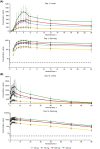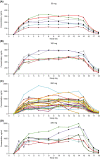Phase I evaluation of the safety, tolerability, and pharmacokinetics of GSK3640254, a next-generation HIV-1 maturation inhibitor
- PMID: 33200887
- PMCID: PMC7670640
- DOI: 10.1002/prp2.671
Phase I evaluation of the safety, tolerability, and pharmacokinetics of GSK3640254, a next-generation HIV-1 maturation inhibitor
Abstract
Despite advances in HIV-1 management with antiretroviral therapy, drug resistance and toxicities with multidrug regimens can result in treatment failure. Hence, there is a continuing demand for antiretroviral agents (ARVs) with novel mechanisms of action. Maturation inhibitors inhibit HIV-1 replication via a unique mechanism of action and can be combined with other ARVs. Two phase I randomized clinical trials were conducted for a maturation inhibitor, GSK3640254, to determine safety, pharmacokinetics (NCT03231943), and relative bioavailability (NCT03575962) in healthy adults. The first trial was conducted in two parts. Part 1 was conducted in a two-cohort, interlocking, eight-period fashion in 20 participants with single ascending doses of GSK3640254 (1-700 mg) or placebo. In Part 2, 58 participants were randomized to receive GSK3640254 (n = 44) or placebo (n = 14). Four participants reported adverse events (AEs) leading to study discontinuation, with one adverse drug reaction (maculopapular rash). There was no relationship between frequency or severity of AEs and dose. Pharmacokinetic assessments showed that GSK3640254 was slowly absorbed, with time to maximum concentration (tmax) occurring between 3.5 and 4 hours and half-life of ~24 hours. In the relative bioavailability study of GSK3640254 mesylate salt vs bis-hydrochloride salt capsules in 14 healthy adults, the mesylate salt performed slightly better than the bis-hydrochloride formulation (12%-16% increase in area under the concentration-time curve and maximum concentration); tmax (5 hours) was similar between the formulations. Initial pharmacokinetic and safety data from these healthy-participant studies informed further development of GSK3640254 for once-daily dosing for the treatment of HIV-1 infection.
Keywords: HIV-1 infection; bioavailability; clinical study; first-time-in-human; healthy participants; pharmacokinetics; safety.
© 2020 The Authors. Pharmacology Research & Perspectives published by John Wiley & Sons Ltd, British Pharmacological Society and American Society for Pharmacology and Experimental Therapeutics.
Conflict of interest statement
Samit R. Joshi, Max Lataillade, and Sherene Min are employees of ViiV Healthcare; Max Lataillade and Sherene Min own stock in GlaxoSmithKline (GSK). Disala Fernando, Stephanie Igwe, Anu S. Krishnatry, Fiona Halliday, Joyce Zhan, Thomas J. Greene, Jianfeng Xu, and Geraldine Ferron‐Brady are employees of GSK and own stock in GSK. Litza McKenzie is an employee of Quotient Sciences, which was contracted by GSK to perform the clinical aspects of the relative bioavailability study, and she served as the principal investigator; Dr McKenzie receives a fixed wage from Quotient Sciences, which is not dependent on the conduct or outcome of any individual study.
Figures





References
-
- DeJesus E, Harward S, Jewell RC, et al. A phase IIa study of novel maturation inhibitor GSK2838232 in HIV patients. Slides presented at: Conference on Retroviruses and Opportunistic Infections; March 4–7, 2019; Seattle, WA.
-
- Morales‐Ramirez J, Bogner JR, Molina JM, et al. Safety, efficacy, and dose response of the maturation inhibitor GSK3532795 (formerly known as BMS‐955176) plus tenofovir/emtricitabine once daily in treatment‐naive HIV‐1‐infected adults: week 24 primary analysis from a randomized phase IIb trial. PLoS One. 2018;13(10):e0205368. - PMC - PubMed
-
- Wainberg MA, Albert J. Can the further clinical development of bevirimat be justified? AIDS. 2010;24(5):773‐774. - PubMed
Publication types
MeSH terms
Substances
Associated data
LinkOut - more resources
Full Text Sources
Medical
Miscellaneous

